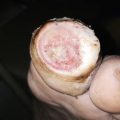Pulse oximeter
Blood pressure cuff with multiple sizes
Digital ear thermometer
Portable digital scale
Stethoscope
Rechargeable otoscope/ophthalmoscope
Hemoccult cards and developer
Ear curettes
Small forceps
Bandage scissors
Bionex ear irrigation kit
Toenail clippers
Water-based lubricant (K-Y jelly)
Vinyl gloves
Hand sanitizer
Finger splints
Scalpels (Nos. 10, 11, and 15)
Phlebotomy supplies—Butterfly 23G needles, vacutainer
Sharps needle box
Silver nitrate sticks
Suture kits
Syringes and needles
Skin staple remover
Wound care supplies—saline, gauze, Kerlix, Opsite and thin hydrocolloid dressings, hydrogel ointment, triple antibiotic ointment, elastic bandage, ABD pads
Povidone-iodine swabs
Injectables—epinephrine, triamcinolone, lidocaine, vitamin B12, furosemide, pneumococcal and influenza vaccines, tetanus/diphtheria toxoids
Disposable measuring tape
Urine cups
Bacterial culture swabs
Vaginal speculums
Flashlight or headlamp
Batteries
Garbage can (regular and hazard red bag)
Disposable chucks
N95 disposable masks
Hand sanitizer
Portable laptop PC
Cell phone and car charger
Hazmat suit—masks, booties, disposable jumpsuit
Forms box—For do-not-resuscitate and comfort care orders, advance directives, new patient packets and brochures, patient labels, consent forms
A home-based primary care team’s success depends in large part on holding an effective and in-person weekly interdisciplinary team meeting. All team members are present to review status of new patients, hospitalized patients, unstable patients, deaths, and several other special categories of high-risk patients. The team meeting list is built by getting patient names from all staff members, and the final list is compiled by the office nurse. Other attendees at the weekly team meeting are representatives from pharmacy, mental health, and a partner skilled home health agency. See Table 2.2 for a sample template of the weekly team meeting. As reimbursement policies change to reward coordination and value, we envision this template being used to document coordination of care time and to justify billing for case management and coordination time.
Table 2.2
Template for weekly interdisciplinary HBPC team meeting
Patient category | Physician name | Nurse practitioner name | Social worker name | Active issue |
|---|---|---|---|---|
New patients | ||||
Hospitalized | ||||
Unstable patients | ||||
New hospice or skilled home health patients | ||||
Anticoagulation | ||||
On hold (SNF facilities, bedbug infestation) | ||||
Recent deaths |
A robust electronic health record (EHR) and a practice management database are essential tools. This means that all clinicians work on one mobile EHR, where they view data from other sectors of health system (e.g., hospital, home care agencies). Where possible, a practice can also link to local health-care integrated advanced information management systems to track patients across settings (e.g., Chesapeake Regional Information System for Our Patients, or CRISP).
Stay updated, free articles. Join our Telegram channel

Full access? Get Clinical Tree




